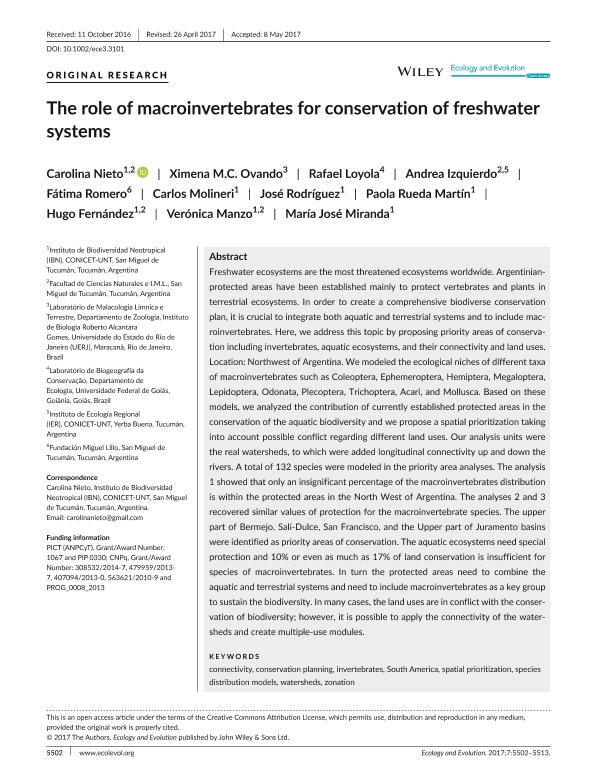Mostrar el registro sencillo del ítem
dc.contributor.author
Nieto Peñalver, María Carolina

dc.contributor.author
Ovando, Ximena Maria Constanza

dc.contributor.author
Loyola, Rafael

dc.contributor.author
Izquierdo, Andrea Elisa

dc.contributor.author
Romero, Vivian de Fátima

dc.contributor.author
Molineri, Carlos

dc.contributor.author
Rodríguez, José
dc.contributor.author
Rueda Martin, Paola Alejandra

dc.contributor.author
Fernandez, Hugo Rafael

dc.contributor.author
Manzo, María Verónica

dc.contributor.author
Miranda, Maria Jose

dc.date.available
2018-11-27T14:27:31Z
dc.date.issued
2017-07
dc.identifier.citation
Nieto Peñalver, María Carolina; Ovando, Ximena Maria Constanza; Loyola, Rafael; Izquierdo, Andrea Elisa; Romero, Vivian de Fátima; et al.; The role of macroinvertebrates for conservation of freshwater systems; John Wiley and Sons Ltd; Ecology and Evolution; 7; 14; 7-2017; 5502-5513
dc.identifier.issn
2045-7758
dc.identifier.uri
http://hdl.handle.net/11336/65291
dc.description.abstract
Freshwater ecosystems are the most threatened ecosystems worldwide. Argentinian-protected areas have been established mainly to protect vertebrates and plants in terrestrial ecosystems. In order to create a comprehensive biodiverse conservation plan, it is crucial to integrate both aquatic and terrestrial systems and to include macroinvertebrates. Here, we address this topic by proposing priority areas of conservation including invertebrates, aquatic ecosystems, and their connectivity and land uses. Location: Northwest of Argentina. We modeled the ecological niches of different taxa of macroinvertebrates such as Coleoptera, Ephemeroptera, Hemiptera, Megaloptera, Lepidoptera, Odonata, Plecoptera, Trichoptera, Acari, and Mollusca. Based on these models, we analyzed the contribution of currently established protected areas in the conservation of the aquatic biodiversity and we propose a spatial prioritization taking into account possible conflict regarding different land uses. Our analysis units were the real watersheds, to which were added longitudinal connectivity up and down the rivers. A total of 132 species were modeled in the priority area analyses. The analysis 1 showed that only an insignificant percentage of the macroinvertebrates distribution is within the protected areas in the North West of Argentina. The analyses 2 and 3 recovered similar values of protection for the macroinvertebrate species. The upper part of Bermejo, Salí-Dulce, San Francisco, and the Upper part of Juramento basins were identified as priority areas of conservation. The aquatic ecosystems need special protection and 10% or even as much as 17% of land conservation is insufficient for species of macroinvertebrates. In turn the protected areas need to combine the aquatic and terrestrial systems and need to include macroinvertebrates as a key group to sustain the biodiversity. In many cases, the land uses are in conflict with the conservation of biodiversity; however, it is possible to apply the connectivity of the watersheds and create multiple-use modules.
dc.format
application/pdf
dc.language.iso
eng
dc.publisher
John Wiley and Sons Ltd
dc.rights
info:eu-repo/semantics/openAccess
dc.rights.uri
https://creativecommons.org/licenses/by-nc-sa/2.5/ar/
dc.subject
Connectivity
dc.subject
Conservation Planning
dc.subject
Invertebrates
dc.subject
South America
dc.subject
Spatial Prioritization
dc.subject
Species Distribution Models
dc.subject
Watersheds
dc.subject
Zonation
dc.subject.classification
Ecología

dc.subject.classification
Ciencias Biológicas

dc.subject.classification
CIENCIAS NATURALES Y EXACTAS

dc.title
The role of macroinvertebrates for conservation of freshwater systems
dc.type
info:eu-repo/semantics/article
dc.type
info:ar-repo/semantics/artículo
dc.type
info:eu-repo/semantics/publishedVersion
dc.date.updated
2018-10-23T17:52:20Z
dc.journal.volume
7
dc.journal.number
14
dc.journal.pagination
5502-5513
dc.journal.pais
Estados Unidos
dc.journal.ciudad
New Jersey
dc.description.fil
Fil: Nieto Peñalver, María Carolina. Consejo Nacional de Investigaciones Científicas y Técnicas. Centro Científico Tecnológico Conicet - Tucuman. Instituto de Biodiversidad Neotropical. Universidad Nacional de Tucuman. Facultad de Ciencias Naturales e Instituto Miguel Lillo. Instituto de Biodiversidad Neotropical. Instituto de Biodiversidad Neotropical; Argentina
dc.description.fil
Fil: Ovando, Ximena Maria Constanza. Consejo Nacional de Investigaciones Científicas y Técnicas; Argentina. Universidade do Estado do Rio de Janeiro; Brasil
dc.description.fil
Fil: Loyola, Rafael. Universidade Federal de Goiás; Brasil
dc.description.fil
Fil: Izquierdo, Andrea Elisa. Universidad Nacional de Tucumán. Instituto de Ecología Regional. Consejo Nacional de Investigaciones Científicas y Técnicas. Centro Científico Tecnológico Conicet - Tucumán. Instituto de Ecología Regional; Argentina. Universidad Nacional de Tucumán. Facultad de Ciencias Naturales e Instituto Miguel Lillo; Argentina
dc.description.fil
Fil: Romero, Vivian de Fátima. Fundación Miguel Lillo; Argentina
dc.description.fil
Fil: Molineri, Carlos. Consejo Nacional de Investigaciones Científicas y Técnicas. Centro Científico Tecnológico Conicet - Tucuman. Instituto de Biodiversidad Neotropical. Universidad Nacional de Tucuman. Facultad de Ciencias Naturales e Instituto Miguel Lillo. Instituto de Biodiversidad Neotropical. Instituto de Biodiversidad Neotropical; Argentina
dc.description.fil
Fil: Rodríguez, José. Consejo Nacional de Investigaciones Científicas y Técnicas. Centro Científico Tecnológico Conicet - Tucuman. Instituto de Biodiversidad Neotropical. Universidad Nacional de Tucuman. Facultad de Ciencias Naturales e Instituto Miguel Lillo. Instituto de Biodiversidad Neotropical. Instituto de Biodiversidad Neotropical; Argentina
dc.description.fil
Fil: Rueda Martin, Paola Alejandra. Consejo Nacional de Investigaciones Científicas y Técnicas. Centro Científico Tecnológico Conicet - Tucuman. Instituto de Biodiversidad Neotropical. Universidad Nacional de Tucuman. Facultad de Ciencias Naturales e Instituto Miguel Lillo. Instituto de Biodiversidad Neotropical. Instituto de Biodiversidad Neotropical; Argentina
dc.description.fil
Fil: Fernandez, Hugo Rafael. Consejo Nacional de Investigaciones Científicas y Técnicas. Centro Científico Tecnológico Conicet - Tucuman. Instituto de Biodiversidad Neotropical. Universidad Nacional de Tucuman. Facultad de Ciencias Naturales e Instituto Miguel Lillo. Instituto de Biodiversidad Neotropical. Instituto de Biodiversidad Neotropical; Argentina. Universidad Nacional de Tucumán. Facultad de Ciencias Naturales e Instituto Miguel Lillo; Argentina
dc.description.fil
Fil: Manzo, María Verónica. Consejo Nacional de Investigaciones Científicas y Técnicas. Centro Científico Tecnológico Conicet - Tucuman. Instituto de Biodiversidad Neotropical. Universidad Nacional de Tucuman. Facultad de Ciencias Naturales e Instituto Miguel Lillo. Instituto de Biodiversidad Neotropical. Instituto de Biodiversidad Neotropical; Argentina. Universidad Nacional de Tucumán. Facultad de Ciencias Naturales e Instituto Miguel Lillo; Argentina
dc.description.fil
Fil: Miranda, Maria Jose. Consejo Nacional de Investigaciones Científicas y Técnicas. Centro Científico Tecnológico Conicet - Tucuman. Instituto de Biodiversidad Neotropical. Universidad Nacional de Tucuman. Facultad de Ciencias Naturales e Instituto Miguel Lillo. Instituto de Biodiversidad Neotropical. Instituto de Biodiversidad Neotropical; Argentina
dc.journal.title
Ecology and Evolution
dc.relation.alternativeid
info:eu-repo/semantics/altIdentifier/doi/https://dx.doi.org/10.1002/ece3.3101
dc.relation.alternativeid
info:eu-repo/semantics/altIdentifier/url/https://onlinelibrary.wiley.com/doi/full/10.1002/ece3.3101
Archivos asociados
